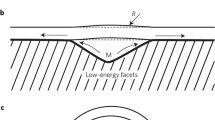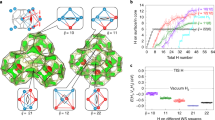Abstract
The nucleating, growing and cracking of hydrogen blister have been investigated experimentally and theoretically. The results show that atomic hydrogen induces superabundant vacancies in metals. The superabundant vacancies and hydrogen aggregate into a hydrogen-vacancy cluster (microcavity). The hydrogen atoms in the microcavity become hydrogen molecules which can stabilize the cluster. And the hydrogen blister nucleates. With the entry of vacancies and hydrogen atoms, the blister nucleus grows and the pressure in the cavity increases. When the stress induced by hydrogen pressure on the blister is up to the cohesive strength, cracks will initiate from the wall of the blister.
Similar content being viewed by others
References
Yen S K, Huang I B. Critical hydrogen concentration for hydrogen-induced blistering on AISI 430 stainless steel. Mater Chem Phys, 2003, 80: 662–666
Tetelman A S, Robertson W D. Direct observation and analysis of crack propagation in iron-3% silicon single crystals. Acta Metall, 1963, 11: 415–425
Ren X C, Shan G B, Chu W Y, et al. Initiating, growing and cracking of hydrogen blisters. Chin Sci Bull, 2005, 50: 1689–1692
Krom A H M, Bakker A, Koers R W. Modelling hydrogen-induced cracking in steel using a coupled diffusion stress finite element analysis. Int J Pres Pip, 1997, 72: 139–147
Garofalo F, Chou Y T, Ambegaokar V. Effect of hydrogen on stability of micro cracks in iron and steel. Acta Metall, 1960, 8: 504–512
Iino M. The extension of hydrogen blister-crack array in linepipe steels. Metall Trans A, 1978, 9A: 1581–1590
Yoshida S, Kiritani M, Shimomura Y. Lattice Defects in Quenching Metals (ed. by Cottrell R M J), New York: Academic Press, 1965. 713–750
Zhou Q J, He J Y, Sun D B, et al. Deformation and fracture of nickel phosphorus coatings. Scripta Mater, 2006, 54: 603–608
Rooke D P, Cartwright D J. Compendium of Stress Intensity Factors. London: Her Majesty’s Stationary Office, 1976. 174
Fukai Y, Okuma N. Evidence of copious vacancy formation in Ni and Pd under a high hydrogen pressure. Jap J Appl Phys, Part 2 (Letters), 1993, 32: L1256–1259
Fukai Y, Okuma N. Formation of superabundant vacancies in Pd hydride under high hydrogen pressures. Phys Rev Lett, 1994, 73: 1640–1643
Fukai Y, Kurokawa Y, Hiraoka H. Superabundant vacancy formation and its consequences in metal-hydrogen alloys. J Jpn Inst Met, 1997, 61: 663–670
Iida T, Yamazaki Y, Kobayashi T, et al. Enhanced diffusion of Nb in Nb-H alloy by hydrogen-induced vacancies. Acta Mater, 2005, 53: 3083–3089
Yamazaki Y, Iijima Y, Okada M. Enhanced diffusion of Au in γ-Fe by vacancies induced under elevated hydrogen pressure. Acta Mater, 2004, 52: 1247–1254
Gavriljuk, V. G, Bugaev, V. N., Petrov, Y. N. et al, Hydrogen-induced equilibrium vacancies in FCC iron-base alloy, Scripta Mater., 1995, 34: 903–907
McLellan R B, Xu Z R. Hydrogen-induced vacancies in the iron lattice. Scripta Mater, 1997, 36: 1201–1205
Maroevic P, McLellan R B. Equlibrium vacancy concentration in Pd-H solid solutions. Acta Mater, 1998, 46: 5593–5597
Feng D. Metallic Physics, Volume I (in Chinese). Beijing: Science Press, 2000. 211–225
Zhang C H, Chen Q K, Wang Y S, et al. Thermal stability of small He-vacancy clusters in 316L stainless steel irradiated with 2.5 MeV He+ ions at 550°C. Nucl Instr Meth in Phys Res B, 1998, 135: 256–259
Morishita K, Sugano R, Wirth B D. MD and KMC modeling of the growth and shrinkage mechanism of helium-vacancy clusters in Fe. J Nucl Mater, 2003, 323: 243–250
Daw M S, Baskes M I. Embedded-atom method: Derivation and application to impurities, surfaces, and other defects in metals. Phys Rev B, 1984, 29: 6443–6453
Author information
Authors and Affiliations
Corresponding author
Additional information
Supported by the National Natural Science Foundation of China (Grant No. 50471096)
About this article
Cite this article
Ren, X., Zhou, Q., Chu, W. et al. The mechanism of nucleation of hydrogen blister in metals. Chin. Sci. Bull. 52, 2000–2005 (2007). https://doi.org/10.1007/s11434-007-0269-y
Received:
Accepted:
Issue Date:
DOI: https://doi.org/10.1007/s11434-007-0269-y




